Japan | Sky Tree, Tokyo
BY PARIS SUMPTER
Paris explores the Sky Tree tower in Tokyo.
Paris Sumper studied abroad in Tokyo, Japan, in Summer 2017: http://eap.ucop.edu/OurPrograms/japan/Pages/language-and-culture-ICU.aspx
BY PARIS SUMPTER
Paris explores the Sky Tree tower in Tokyo.
Paris Sumper studied abroad in Tokyo, Japan, in Summer 2017: http://eap.ucop.edu/OurPrograms/japan/Pages/language-and-culture-ICU.aspx
BY BARRY YANG
The Way of the French
When I arrived in France I spoke absolutely no French. Now, approximately a month later, I still speak no French. Well that is an exaggeration, but my comprehension and conversational skills are still very very very low. Unfortunately, the language class offered at Sciences Po Lyon does not contain a beginner’s level. Students with similar levels of French are bunched up in one class. Since everyone speaks mountains more French than me, the lowest level class is still 100 times passed my comprehension level. However, as the French say, c’est la vie.
This brings me to our French language instructor Professor Christophe. A curly haired friendly French man who largely refuses to speak English in class, Professor Christophe has a tendency to call on me to answer questions when he very well understands that my French skills are impoverished. I found the class initially very boring as I understood little to nothing that was going on. However, as time went on, Professor Christophe and I developed a friendly relationship filled with lively incoherent conversations that involved him partially understanding my English and me not understanding his French at all. Even though there is a huge language gap and a steep learning curve, I am having a great time in this class. Professor Christophe is a very nice teacher and takes the time to individually teach me the pronunciations and make sure that I’m not completely clueless as to what is going on. A soft spoken yet firm teacher, Professor Christophe is a lot of fun and has a good sense of humor. I am very glad that he takes my jokes well and enjoys my random comments in English (at least I hope he does). I could not be happier that I am learning French from him, and I really respect and appreciate the effort he puts in both in and out of class to ensure that he is able to help and advance every student regardless of the their French levels.
Yvan celebrating his birthday!

MEET MY FRENCH BROTHER PAUL-ELIOT
I have seen a lot of French students in the streets of Lyon, but none have been as inappropriately funny as my French home-stay brother Paul-Eliot. A 15 year old boy of many not so politically correct and PG jokes, Paul- Eliot constantly shows me French memes and translates them into English for me. I thoroughly enjoy helping him with his English homework and giving him a hard time whenever his teacher gives him a bad mark (all in good fun of course).
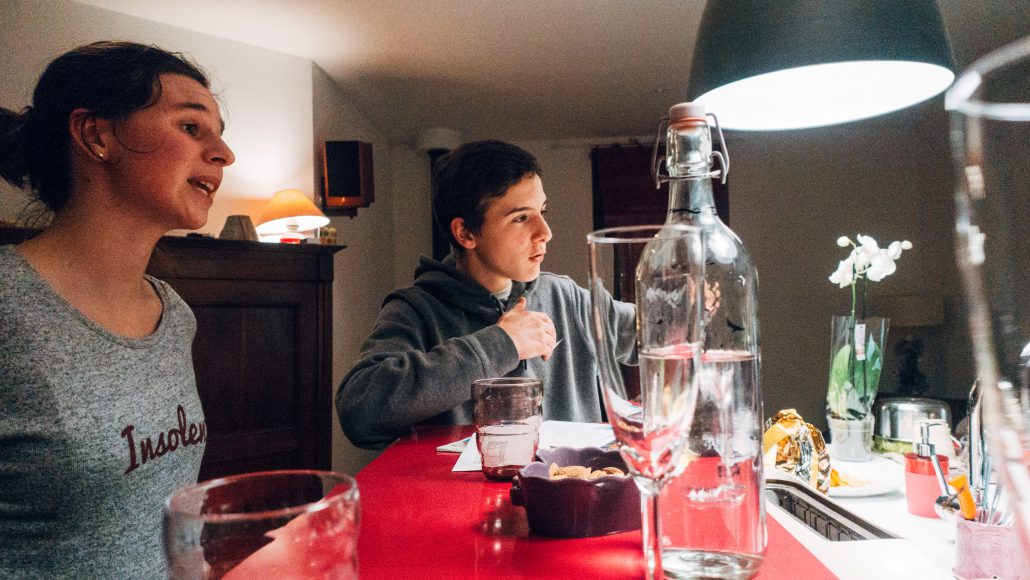
For a 15 year old, Paul-Eliot stays pretty busy. On Thursdays he has almost 9 hours of class and every Wednesday he does not get home from his “Fireman” activity until 8:30PM. Apparently, in France, the Firehouse holds activities where students can go to learn the duties of a fireman and engage in some exercise and workouts. The Firehouse also puts on a “Fireman Ball” where members of the community and participants of the Fireman class are invited to a soiree filled with small eats and dancing. My host family regularly attends; sadly I was not able to join this time because of my trip of Avignon.
Paul-Eliot is just one of the many great characters in my French family. Stay tuned for next week when I introduce my French sister Lison.
A WEEKEND IN ANOTHER SMALL TOWN
If one follows the Rhone river towards the Southern region of France, past Lyon, one arrives in a region known as Provence. While extremely beautiful during the summer, the sights during the winter are not so shabby either. A region that produces some great wines and picturesque postcards, Provence has been one of mine and my girlfriend’s favorite regions. In addition to being very beautiful, the region is also very cheap to get to via Flixbus, Ouibus, or Ouigo. For around 9-12 euros, you can make your way to some beautiful French towns and get away from the humdrum of the cities.
This weekend we visited Nimes, which is only about an hour away from Avignon (our choice of travel for last week). The city is very small, but has some amazing Roman architecture scattered throughout the town. In addition to a small pantheon, there is a very big Colosseum as well as beautiful statues. 20 kilometers outside the city is Pont du Gard. Pont du Gard is the highest of all elevated Roman aqueducts and listed as an UNESCO World Heritage Site for its historical significance. The aqueduct was built as part of a 50 kilometer water system that carried water from a spring at Uzes to the Roman colony of Nimes. At almost 50 meters tall, Pont Du Gard is an amazing architectural feat. It is hard to believe that people were able to build something of this caliber in the first century AD without heavy machinery or tools. That is Roman ingenuity I guess.
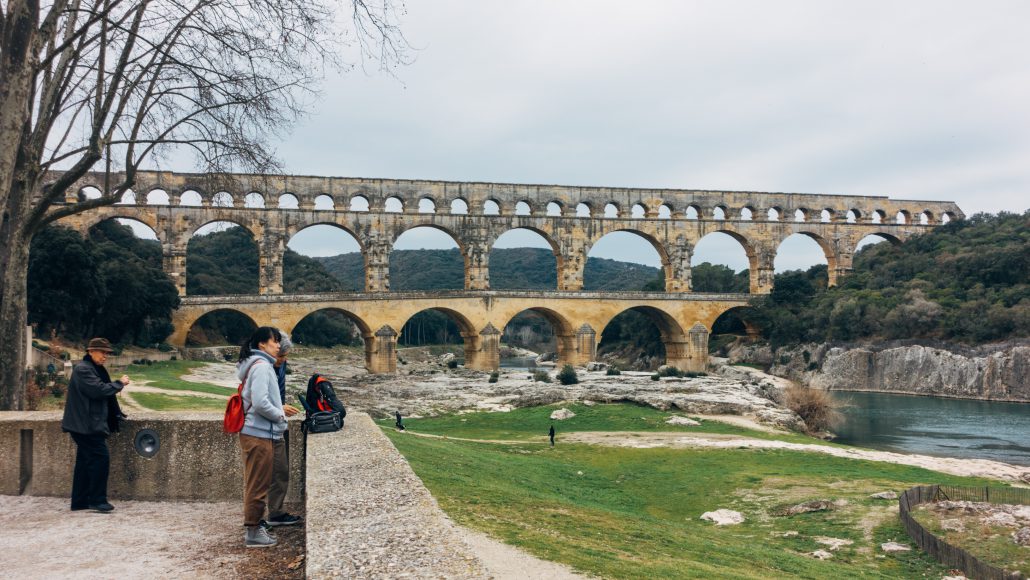
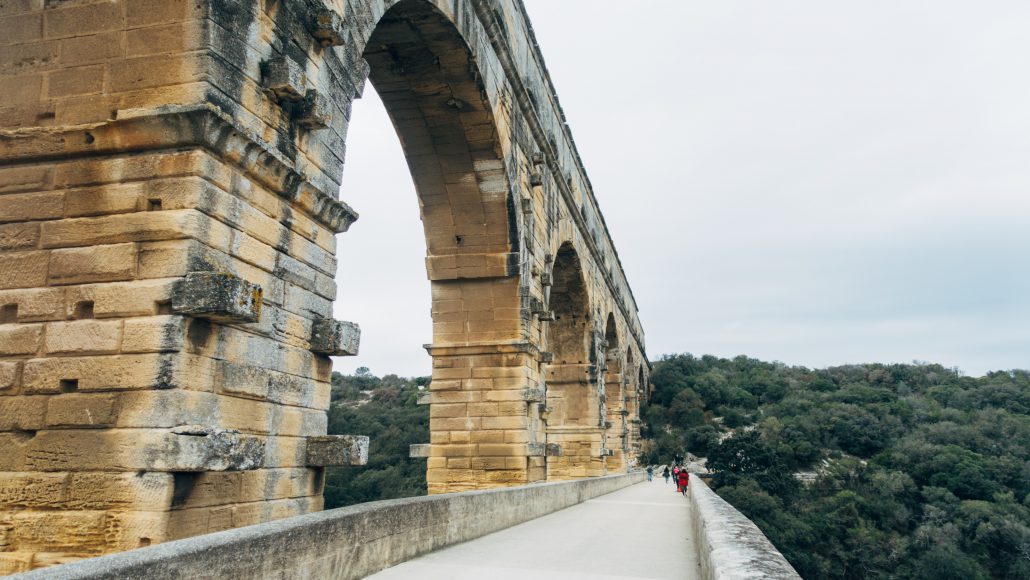
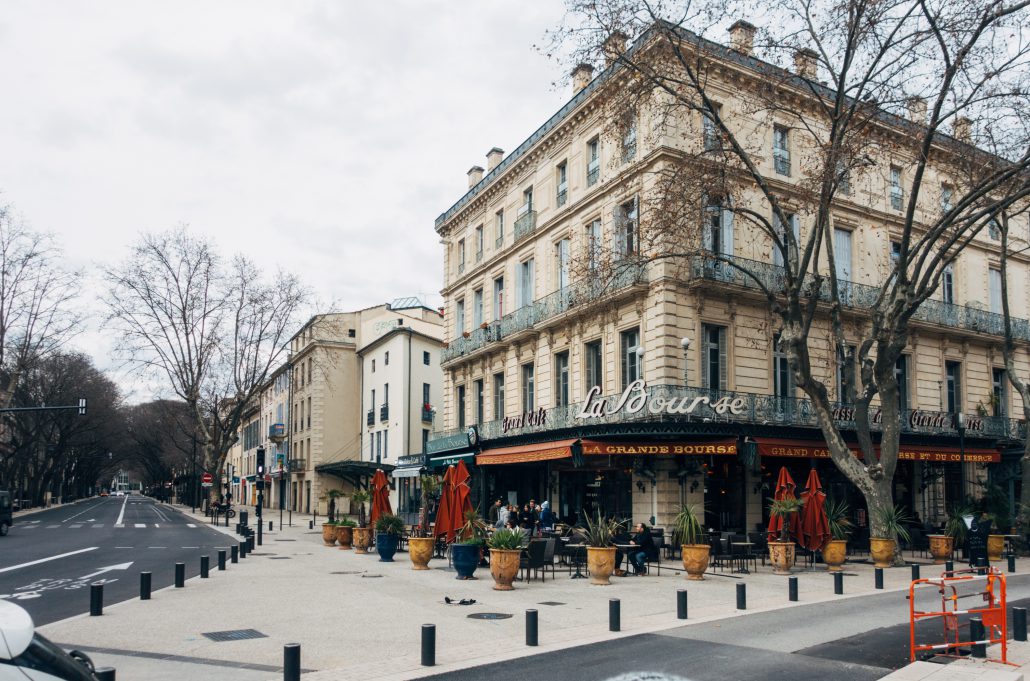
In addition to Pont du Gard, Nimes is just incredibly quaint and cozy. The buildings are extremely close together and the streets very narrow. With only 140,000 inhabitants, the city is sparsely populated despite its small size and there are few crowds like the ones one would see in Lyon or Paris. The public transit in the town should not be disregarded simply due to the city’s size. At only 160 square kilometers, Nimes has arguably a better public transport system than some of the biggest metropolises in the United States. The buses run every 7 minutes and only costs 1.5 euros for a ticket. One can easily get all around town on the bus, and there is little need to own a car. There is even a more extensive transport system that will take you to near by towns such as Uzes, Ales, and Poet du Gard for the same 1.5 euros. Overall, Nimes is a beautiful city and definitely worthy of at least a day trip.
I got the opportunity to fly my drone and make a video of the small city; the video can be found here: https://youtu.be/dSIgv9QDVVU
Barry Yang studied abroad in Lyon, France, in Spring 2017: http://eap.ucop.edu/OurPrograms/france/Pages/default.aspx
BY CELIA CODY-CARRESE
It’s dark when I leave my house at 7:20 am, travel backpack on and umbrella in hand, in case it rains in Granada. Our program is meeting near a park, where the streets are somewhat maze-like, and thus I walk in the wrong direction. Right about when I figure out that I am not going where I should be, I run into three other students who are in the same boat. We put our heads together and find our way to the bus, chuck our stuff in the storage compartment, and get settled for the two and a half hour ride to Granada.
For our Friday excursion during week three, we went to Granada to visit the Alhambra palace. Since the bus was already taking us there, most of the program decided to stay in Granada till Sunday, to further explore the city. But first, the Alhambra.
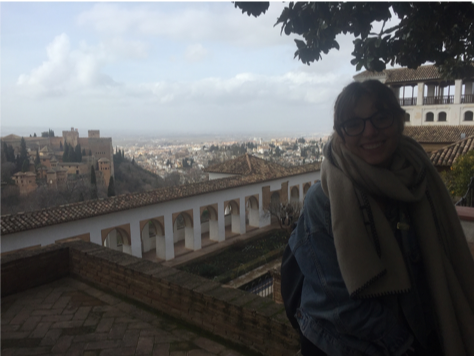
Fun fact: The Alhambra is the most visited monument in Spain! The palace which represents the last great Muslim kingdom in Europe drew over 2.4 million people in 2014. The Alhambra began as a small fortress and was expanded into a palace in the mid 13th century by the Moorish emir, or leader, at the time. In 1492, once Fernando and Isabel had expelled the Muslims out of Spain, they used the Alhambra as their Royal Court. They made a few changes to the complex, but overall the Alhambra is a stunning example of Muslim architecture. The palace boasts grand rooms, gardens, reflective pools, and a lot of intricate ceilings and arches- my favorite architectural details. The walls and ceilings all have extremely detailed inscriptions in Arabic, as well as carvings of geometric shapes, fruits and flowers, and other beautiful details. Part of the Alhambra complex is the Medina, which was a town where people who created products or worked to support the operations of the palace lived. Walking through the Medina’s pathways and gardens feels like a medieval fairytale.

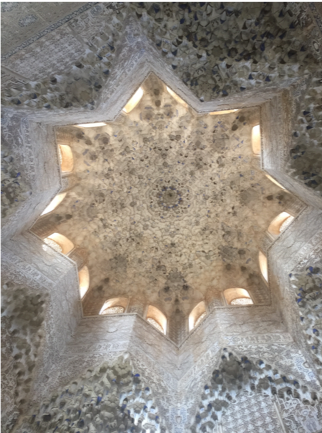
After the Alhambra, we headed to our hostels- I stayed at Marakuto hostel in Granada’s Albaicín neighborhood, a hilly and cobblestone lined maze of narrow streets. (The cobblestones in Granada are very charming but also very small and bumpy, hence the title of this blog- after a weekend of walking probably about 7 or 8 miles a day, my feet were pretty sore-worth it though!) Our hostel had hammocks and a treehouse, and after dropping off our things we joined a walking tour Marakuto provides. We walked through the Albaicín to several lookout spots, including an old house with a patio and a great view of the Alhambra. Then we made our way to the hills of Sacramonte, another old neighborhood in Granada. At the northern edge of the city, Sacramonte is at the base of a large hill, which you can walk up to get an amazing view of Granada and the Alhambra. We went at sunset and had the most beautiful view of the city and the sky. The golden, glowing lights of the Alhambra and the city slowly took over for the sun before our eyes.
The treehouse at Makuto hostel!
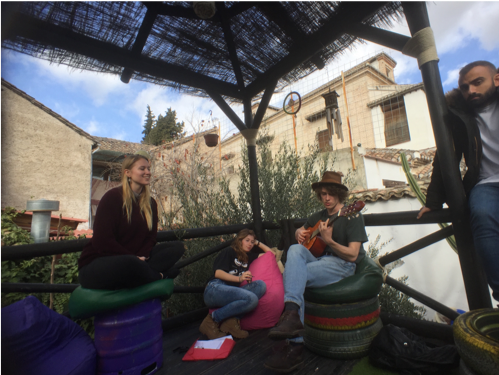
View of Granada and the Alhambra (on the far left) at sunset
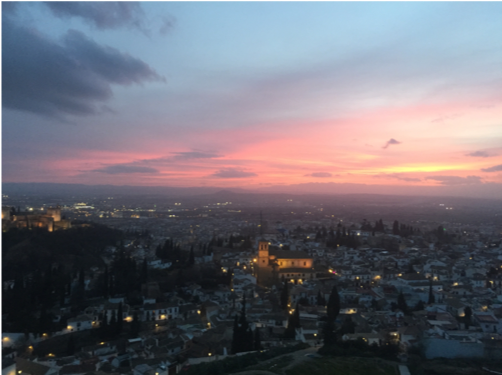
After a much needed hour of relaxing at our hostel, we got ready to go out for tapas! In Granada the tapas are legendary because they are almost always free, and they are also supposed to be some of the biggest tapas you can get in Spain. I personally didn’t have any enormous tapas, but some of my friends did! After two bars we had a sufficient dinner, for super cheap. (Side note: I am going to miss a lot of things about Spain when I go back to California- but I think one of the hardest adjustments is going to be paying for food! Everything here is so much cheaper than in the US!) After tapas we met up with some other students in our program and went out dancing- and like typical Spaniards we took our time getting home.
The next day we went explorin’! After toast and coffee at the hostel, I went with a friend to the center of Granada. First we saw the Capilla Real, or Royal Chapel, which is part of the Catedral de Granada (the free part, to be exact). Fun fact: Fernando and Isabel, the king and queen who expelled the Muslims from Spain, funded Colombus’s expedition, and expanded Spain’s empire in Europe and the “new world,” are buried in the Catedral de Granada. We had a pretty special moment in the Capilla, because the choir was having rehearsal while we were visiting. It’s really incredible to be in a beautiful church while such haunting and divine music is being sung 50 feet away from you.
Altar of the Capilla Real
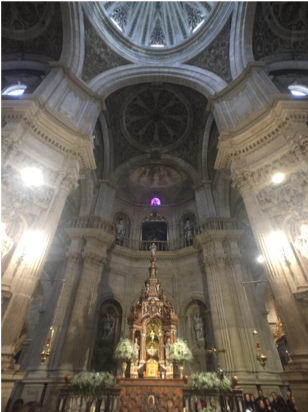
Patio in the Albaicín
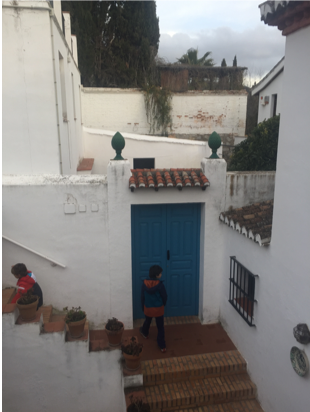
After the Capilla we walked around the Realejo, the old Jewish quarter of Granada. For some reason this neighborhood has a lot of graffiti, and me and my friend tried to see how much of it we could translate! After walking around we met up with some friends at a really good brunch place, Baraka, and I had my second breakfast of the day. Sometimes, one breakfast just isn’t enough. For the rest of the afternoon, we went to a park, explored the city by foot, and then returned to our hostel for some much needed R&R!
For our second and final night in Granada we went out for tapas again, of course, this time with some new found friends from our hostel. We had quite an international group-with us were people from Denmark, Argentina, Germany, and England! To maximize our options we went to Calle Elvira, a street lined with tapas bars at the base of the Albaicín neighborhood. There were probably about 10 bars and 5 kebab places (kebab and falafel are the go-to late night foods in Spain) in three blocks on Calle Elvira! We went to one bar for a bite to eat and then later to a few places for dancing. Fun fact: It’s fairly common for bars in Europe to have foosball tables, which you can pay a euro for and get about 5 balls to play with. I played with some of our friends from the hostel- who were all way better than me because they play a lot, whereas I haven’t played since I was maybe 15.
For my last day in Granada, I met up with more people in our program to enjoy the city. There is a lot to do in Granada but it’s really quite beautiful to just walk around, you’re bound to run into something interesting! We went into a church and also by a creek that runs below the Alhambra. Afterwards we got churros con chocolate and ice cream before hopping on the bus back to Córdoba!
My time in Granada was truly magical, the city as a whole is historical and beautiful, at the same time grungy and kitschy. Every street holds new smells, sounds, and sensations. I can’t wait until I can go back!
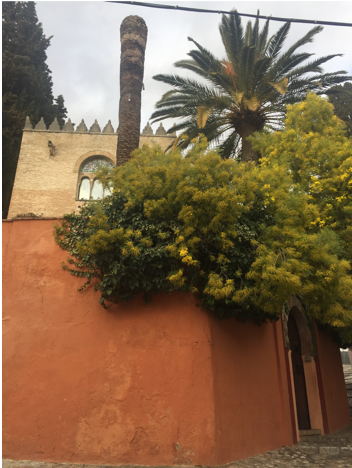
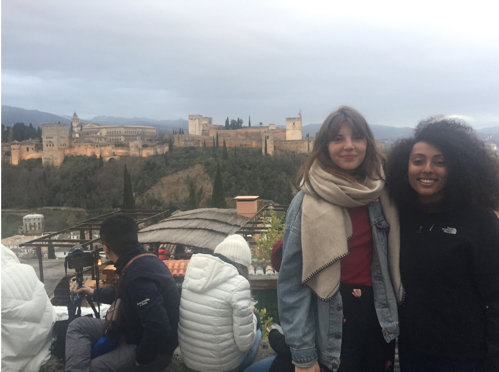
Celia Cody-Carrese studied abroad in Cordoba, Spain, in Winter 2017: http://eap.ucop.edu/OurPrograms/spain/Pages/exploring_andalucia.aspx
